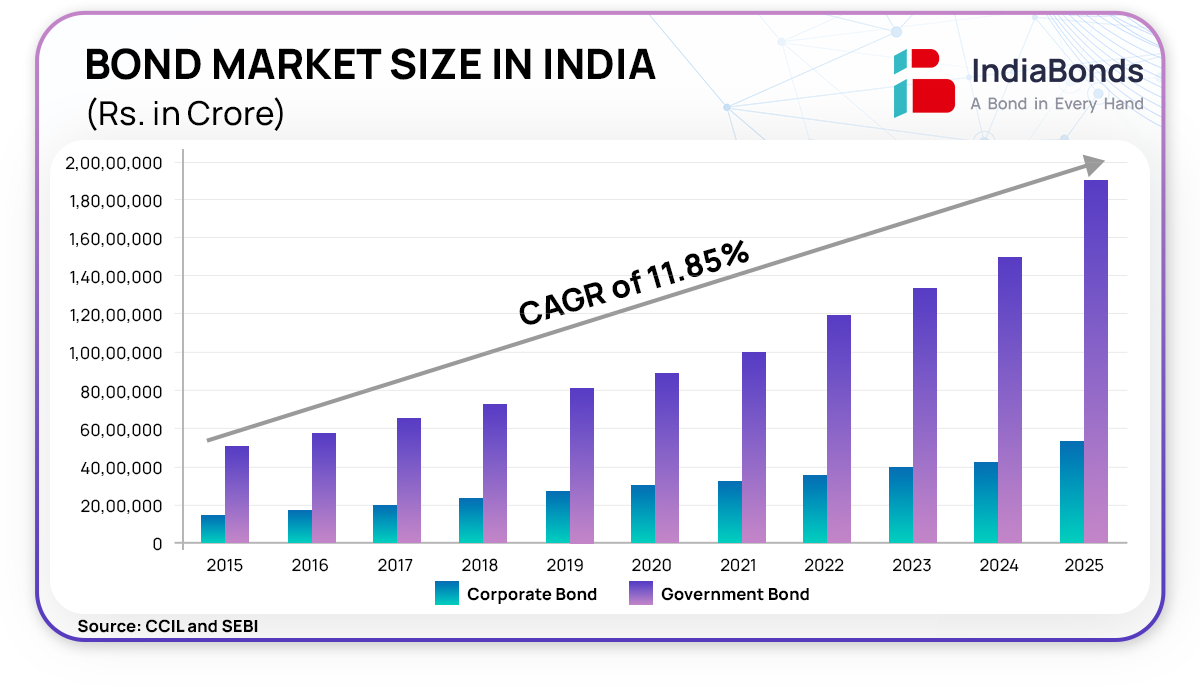Size of the Indian Bond Market is US$ 2.78 trillion!

Introduction
The Indian bond market is a critical component of the nation’s financial ecosystem. This substantial market size not only highlights the maturity and depth of India’s debt instruments but also underscores the potential for future growth. In the context of global financial landscapes, where the world’s bond market stands at a staggering US$145 trillion, India’s bond market emerges as a significant player with immense opportunities for expansion. This article explores the current state and future prospects of the Indian bond market, providing insights into its structure, growth trajectory and the pivotal role it plays in funding the nation’s economic aspirations.
Global Sizing
The world’s GDP was estimated to be around US$111 trillion (Source: World Bank), the world equity market cap stood at US$126 trillion and the global bond market at US$145 trillion (Source: SIFMA). The stats for the largest economy in the world are even more interesting. The US GDP in 2025 was estimated to be US$29 trillion. Its equity market cap was at US$62 trillion, but its bond market was a whopping US$58 trillion! (Source: SIFMA). These numbers have seen significant growth post-2020 due to the massive stimulus and liquidity injection by the US following the Covid-19 pandemic. The All India equity market capitalization stood at almost US$5.10 trillion (Source: BSE). As you already know, the Indian bond market now stands at about US$2.78 trillion (Source: CCIL and SEBI). It is striking to observe that although the bond market in India is large, it has a significant scope for explosive growth from here.
Market Structure

The bond markets in India have matured significantly in the last ten years, providing a relatively safe investment avenue for investors. The broad segments of the market are Central Government Securities (G-Sec), State Development Loans (SDL) and Corporate Bonds. Market depth in these securities has experienced consistent growth in terms of primary issuance as well as growing trading volumes in the secondary market.
RBI regulates G-secs, SDLs and money markets, while SEBI regulates the corporate bond market. If you were not already aware, you will be surprised to know that almost everyone is indirectly an investor in the bond markets. This is because the largest institutional investors in bond markets are all the insurance companies, pension funds and mutual funds. Apart from the domestic institutions, other significant investments come from FPIs (Foreign Portfolio Investors). Another aspect that is gradually growing is the retail and individual investment participation, specifically in the corporate bond market.
The Indian Context
The outstanding bond market in India is valued at US$2.69 trillion (Source: CCIL and SEBI), showing an annual growth of 12.3% in INR terms from the previous year. The corporate bond market, valued at US$598.2 billion, also grew by 12.6% year-over-year. Structurally, the debt market remains skewed towards government securities (G-secs). To put this into perspective, the outstanding government securities stock is Rs. 1,04,00,996 crores (US$1.24 trillion), while the outstanding corporate bonds are Rs. 50,12,254 crores (US$598.2 billion) (Source: CCIL and SEBI).

The entire bond market in India has grown at an impressive annual rate of 12.6% in INR terms in the past decade. This growth is indicative of the expanding role of bond markets in India’s financial ecosystem. Moreover, the inclusion of Indian bonds in global indices by JP Morgan and Bloomberg has put Indian fixed income on the global map.
SEBI Amendments for Corporate Bonds
SEBI has recently proposed pivotal changes to the corporate bond market, significantly reducing the minimum investment size from INR 1 lakh to just INR 10,000. This phased reduction—from ₹10 lakh to ₹1 lakh and now to ₹10,000—aims to increase participation while maintaining safety. Additionally, SEBI has introduced two key changes to enhance market efficiency: standardizing record dates for bond interest payments and redemptions to 15 days before the due date, streamlining operations and clarifying payment timings for investors and enhancing the dissemination of financial information through technologies like weblinks and QR codes, reducing paper reliance and ensuring swift access to vital details. The creation of Online Bond Platform Providers (OBPPs) and tighter regulations on unlisted bonds further demonstrate SEBI’s commitment to expanding the market while safeguarding investor interests. We are standing at the cusp of a bond revolution in India, and the factors stated above are only going to poise the market for unprecedented growth and participation.
Key Drivers of Growth in India’s Corporate Bond Market in 2025
The year 2025 is shaping up to be a significant milestone for India’s corporate bond market. Several key drivers are expected to accelerate growth and strengthen participation. First, the regulatory push by SEBI to enhance transparency and streamline disclosures has instilled greater investor confidence. With improved market infrastructure such as electronic bidding platforms (EBP) and Request for Quote (RFQ) systems, corporate bond trading has become more accessible and efficient. Second, rising credit demand from NBFCs and infrastructure projects is fueling higher issuance volumes, particularly from sectors such as renewable energy, logistics, and housing finance. Retail participation is also gaining momentum, thanks to the rise of Online Bond Platform Providers (OBPPs) that allow investors to directly access bonds in a user-friendly manner. Institutional investors, including mutual funds and insurance companies, are increasingly diversifying allocations towards corporate debt in search of higher yields compared to traditional government securities. Finally, India’s inclusion in global bond indices has boosted foreign investor appetite, creating a more liquid and competitive market environment. Together, these drivers underline the corporate bond market’s growing role in financing India’s economic expansion while opening new opportunities for a diverse set of investors.
Challenges Faced by the Indian Debt Market in 2025
Despite strong growth prospects, the Indian debt market in 2025 faces its share of structural and cyclical challenges. One major concern is the limited secondary market liquidity in corporate bonds, which often discourages active trading beyond the initial issuance. While reforms have made progress, participation remains concentrated among a few institutional players, leaving retail and smaller investors with fewer exit options. Another challenge stems from credit risks associated with issuers, particularly in the NBFC and mid-tier corporate space, where defaults or downgrades can significantly impact investor sentiment. Interest rate volatility is also a persistent issue, as shifts in monetary policy directly affect yields and pricing. Additionally, regulatory compliance and disclosure norms, while critical for transparency, can increase costs for issuers and act as a barrier for smaller companies seeking to raise funds through bonds. On the global front, heightened geopolitical tensions and currency fluctuations pose risks for foreign investors, potentially limiting cross-border flows. Moreover, the Indian debt market continues to face competition from bank lending and equity markets, which remain more familiar routes of capital raising. Addressing these challenges will require a balanced approach of policy reforms, enhanced credit assessment mechanisms, and investor education to deepen trust and participation in the market.
2025 Outlook for India’s Corporate Bond and Fixed Income Markets
Looking ahead, India’s corporate bond and fixed income markets are expected to see steady expansion in 2025. Corporate bond issuances are likely to rise as companies diversify funding sources away from bank credit. At the same time, government bonds will remain a cornerstone for conservative investors, especially with higher retail participation through platforms like RBI’s Retail Direct and OBPPs. Yields are projected to remain attractive relative to global peers, keeping India on the radar of foreign investors. With technology simplifying access and SEBI-driven reforms deepening transparency, the fixed income market is poised to play a critical role in financing India’s growth story while offering investors diversified opportunities across risk-return profiles.
Outlook for the Future
S&P Global Ratings has revised India’s credit rating outlook from ‘stable’ to ‘positive,’ highlighting policy consistency, significant economic reforms and substantial infrastructure investments as key factors driving sustained long-term growth. The projected growth of India’s GDP to US$5 trillion in the next few years is going to be funded largely by credit provided to corporations through the bond markets. We have already witnessed this in the western economies where the corporate bond market is a large percentage of GDP (up to 50-65% in some cases). As India transitions from a developing to a developed economy, the sophistication and depth of its financial markets hold the key to economic upliftment. Households that transfer their huge savings to investments and in this case to a safer asset class of corporate bonds, will likely spur exponential growth of corporate bonds and provide the funding for India’s credit story. It is our effort at IndiaBonds to be a catalyst for this growth and make bond investments easy for individuals. Currently, bond markets are big – however, they are only going to get bigger! Don’t get left behind…
Disclaimer: Investments in debt securities/ municipal debt securities/ securitised debt instruments are subject to risks including delay and/ or default in payment. Read all the offer related documents carefully.























































